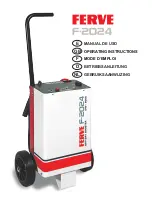
11
Furling in Wind mode
Furling in Wind mode
Furling in Wind mode
Furling in Wind mode
The DuoGen’s wind mode incorporates self-furling.
This can be viewed as analogous to a yacht heeling to gusts of wind.
In light breezes, the DuoGen’s air rotor will point almost directly at the wind. As the wind speed increases, it
will begin to furl about the main tower pointing progressively off the wind.
Once a gust has passed, the air rotor will move back more closely to the wind direction.
The effect of this furling action is to progressively reduce the intercept area of the air rotor in response to
rising wind speeds, in much the same way that heeling reduces effective sail area on the yacht.
High electrical outputs are maintained,
but the wind loading on the DuoGen, its mounting and ultimately
the yacht’s moorings, are controlled. In moderate breezes, the rotor may sit 5º to 10º off the wind, and in
high winds 20º to 30º. In practice, you will observe the DuoGen furling gently as a heavy gust of wind
strikes, and then return to its original position as the gust passes.
The furling force
is provided by the alternator’s reluctance to be accelerated. This furling force is balanced
by the wind loading on the air turbine rotor, and the DuoGen’s yaw arm, which acts like a tail.
In certain conditions, excessive or erratic furling may be observed. Probable causes are:
a) the
operation of the regulator
- as the regulator starts to dump power, the alternator suddenly becomes
‘stiffer’ to turn and this produces a large increase in the furling force.
b)
turbulent air
- as the furling force is balanced primarily by the wind loading on the rotor disc, turbulence
and sudden ‘holes’ in the wind can result in an excessive and erratic furling action. Such turbulence is
usually caused by obstructions upwind or down wind of the turbine, and are particular to a certain
location and wind direction.
c)
mechanical or electrical fault
- usually indicated by low or no electrical output, and/or undue
mechanical friction and noise.
d)
stiffness in the yaw bearing
- usually caused by dirt or salt on the bearing surfaces. The yaw bearings
are of a dry running plastic type, designed to run on anodised aluminium.
Periodic flushing with fresh water and polishing the tower tube with a silicone-based furniture polish should
restore free movement.
When l
ying at anchor with the wind mode deployed
, the furling action can be disabled by inserting the
yaw arm spring plunger in the 10 mm hole at the top of the main tower. This locks the yaw arm with the air
rotor facing directly towards the bows. The yacht herself now keeps the air rotor pointing at the wind, and
power outputs for a given wind speed will generally be higher.
A similar effect can be achieved by restraining the yaw arm with shock cord or a lashing.
We recommend that you restore the furling action if the wind speed exceeds 25 knots or if you
leave the boat.











































